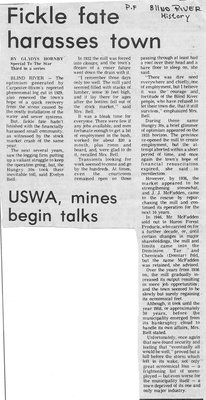Fickle Fate Harasses Town, 1980
- Full Text
Fickle Fate Harasses Town
BY GLADYS HORNBY Special To The Star
Third in a series
BLIND RIVER — The optimism generated by Carpenter-Hixon's reported phenomenal log cut in 1929, also renewed the town's hope of a quick recovery from the stress caused by the costly installation of the water and sewer systems.
But, fickle fate " hadn't finished with the financially harassed small community, as witnessed by the stock market crash of the same year.
The next several years, saw the logging firm putting up a valiant struggle to keep the operation going, but, the Hungry 30s took their' inevitable toll, said Evelyn Bell.
In 1932 the mill was forced into closure, and the town's dream of a rosier future went down the drain with it.
"I remember those days only too well. The mill yard seemed filled with stacks of lumber, some 30 feet high, and it lay there for ages after the "bottom fell out of the stock market," said Mrs. Bell.
It was a bleak time for everyone. There were few if any jobs available, and men fortunate enough to get a bit of employment in the bush, worked for about $20 a month, plus room and board, and, were glad to do it, recalled Mrs. Bell.
Transients looking for work seemed to come and go by the hundreds. At times, even the courtroom remained open so those passing through at least had a roof over their head and a bare floor to sleep on, she said.
"There was dire need everywhere and chiefly, one of employment, but I believe it was the courage and, fortitude of the Blind River people, who have refused to let their town die, that it still survives," emphasized Mrs. Bell.
During those same Hungry 30s, a brief glimmer of optimism appeared on the 1935 horizon. The province re-opened the mill to create employment, but the attempt aborted within a short period of time, and once again the town's hope of financial resuscitation expired, she said in recollection.
However, by 1936, the market appeared to be strengthening somewhat, and J. J. McFadden, came to the rescue by repurchasing the mill and continued its operation for the next 10 years.
In 1946, Mr. McFadden sold out to Huron Forest Products, who carried on for a further decade, or, until certain changes in major shareholdings, the mill and limits came into the Dominion Tar and Chemicals (Domtar) fold, but the name McFadden was retained, she advised.
Over the years from 1936 on, the mill gradually increased its output resulting in more job opportunities; and the town seemed to be slowly but surely regaining its economical feet.
Although, it took until the year 1958, or approximately 30 years, before the municipality emerged from its bankruptcy cloud to handle its own affairs, Mrs. Bell stated.
Unfortunately, once again that new-found security and feeling that "eventually all would be well," proved but a lull before the storm which left in its wake, not only great economical loss - a frightening list of unemployed - but even worse for the municipality itself - a town deprived of its one major industry.
- Creator
- Gladys Hornby, Author
- Media Type
- Text
- Item Type
- Clippings
- Description
- This article appears to be the third in a series of articles discussing the effect of the ups and downs of the lumber industry on the town of Blind River. This piece covers a period from 1929 to 1958.
- Publisher
- Sault Star
- Place of Publication
- Sault Ste Marie, Ontario
- Date of Original
- Circa 1980
- Subject(s)
- Collection
- Blind River History
- Language of Item
- English
- Geographic Coverage
-
-
Ontario, Canada
Latitude: 46.18336 Longitude: -82.95817
-
- Copyright Statement
- Protected by copyright: Uses other than research or private study require the permission of the rightsholder(s). Responsibility for obtaining permissions and for any use rests exclusively with the user.
- Contact
- Blind River Public LibraryEmail:brpl.ceo@gmail.com
Website:
Agency street/mail address:8 Woodward Avenue
P.O. Box 880
Blind River, ON P0R 1B0
(705) 356-7616


